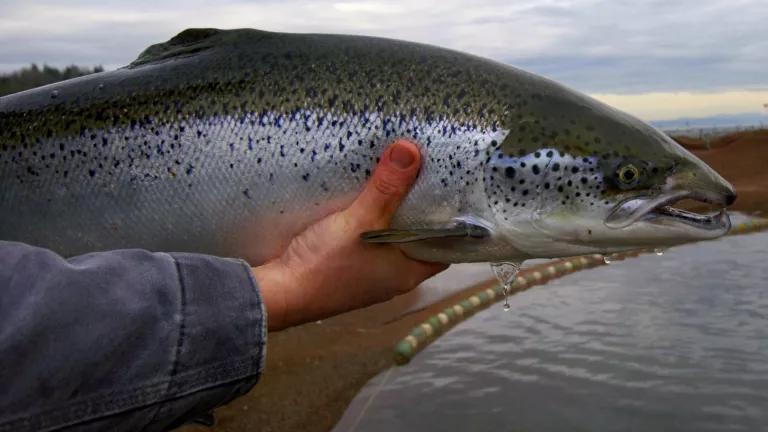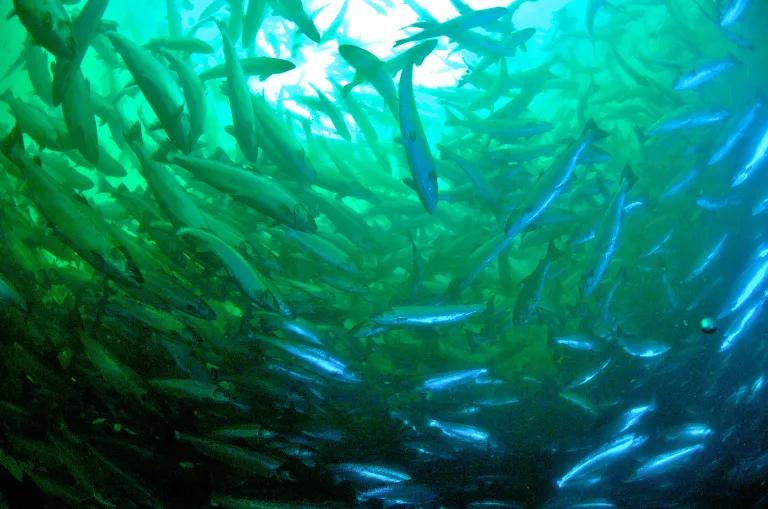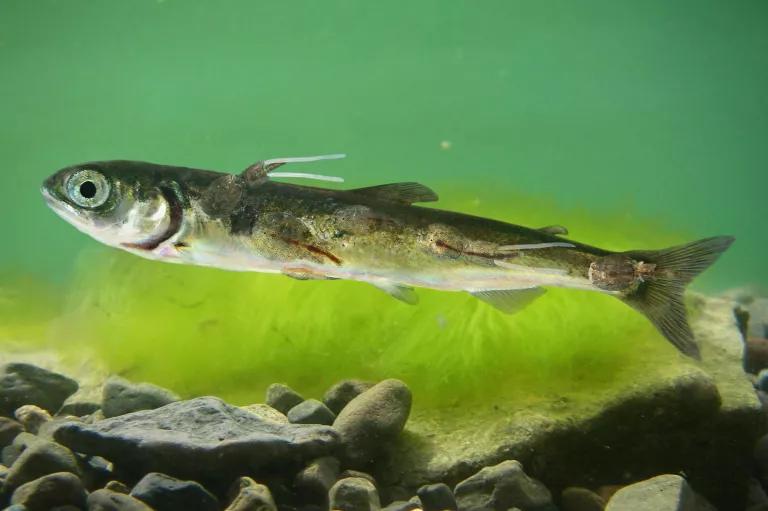Something Fishy: The Trouble with Atlantic Salmon in the Pacific Northwest
Fish farms boost the risks of sea lice infestations, chemicals in the water, and accidental spills that leave native fish floundering.

The marine equivalent of a mass jailbreak took place on August 20. Hundreds of thousands of Washington State–farmed Atlantic salmon were accidentally released into the Salish Sea after their underwater net pens collapsed at a salmon farm near Cypress Island. The potential victims: local wild fish, many of them endangered or threatened, which will now face increased competition for food and habitat. The Lummi Nation Indian tribe quickly declared a state of emergency, writing in an official statement, “The Atlantic salmon spill has the potential to devastate native salmon stocks critical to the culture and the economy of the Lummi Nation.”
That spill is just the latest demonstration of why these farmed fish are controversial. Atlantic salmon are nonnative to the Pacific Northwest but considered easy to farm for commercial purposes in the region’s cold saltwater, where they grow large, taste good, and are said to resist infection better than the local wild fish. But although salmon farming is allowed in Washington State and its northern neighbor, British Columbia, it’s not considered benign in other states—in fact, it’s banned entirely in Alaska and California due to increasing concerns of fishermen, indigenous groups, environmental advocates, and the public.
Experts are still debating why the net pens broke, but the problem is simple, says Patty Lovera, assistant director of Food and Water Watch, a national nonprofit focused on business and government accountability relating to food, water, and corporate overreach. “Atlantic salmon are in the Pacific Ocean, and these fish don’t belong there,” she says.
Issues with Farmed Atlantic Salmon
Atlantic salmon are rarely found in the wild today, Lovera says, due to habitat destruction, dams, and overfishing. “There are not many left,” she says. “They’re not in good shape, numbers-wise.” The United States currently imports most of its for-consumption Atlantic salmon from farms in Norway, Chile, and Canada, augmented by domestic production in Washington and Maine. Cooke Aquaculture, which owns the pens involved in the August 2017 salmon spill, owns most of Washington’s net pens as well as salmon farms in Canada, Scotland, Chile, and Maine.
Atlantic salmon are raised in net pens in open marine waters; in a conventional setup, a mesh net is suspended within a framework of wood, plastic, or steel, held in place by weights. Fish can escape the pens due to heavy storms, damage from boats, vandalism, or just poor maintenance. The 30-year-old pens at Cypress Island had been slated for an upgrade, but Cooke initially blamed the failure on “exceptionally high tides and currents,” and the exact cause is still being debated. In addition to fighting the native species for food and space, some Atlantic salmon may even interbreed with the local fish, although there isn’t yet proof that they have done so in the Pacific Northwest.

In North Atlantic nations, fishermen catch a “boggling” number of escaped farmed salmon, Lovera says.
As for the Cooke spill, as of the end of September 2017, the company had accounted for a little more than 200,000 of the 305,000 escaped fish, with some caught in the failing net and another 49,892 recovered through a fish buyback program that cost the company $1.5 million.
The pens pose environmental hazards even if the fish don’t escape. The open nets permit the flow of waste, parasites, bacteria, and diseases into surrounding waters, where can infect native fish stocks and surrounding wild populations of salmon. There is also the danger of the chemicals that are used to fight disease and parasites, says Lovera. Moreover, farm-raised fish fall under U.S. Food and Drug Administration standards, which often rely on companies to regulate themselves to meet food-safety laws.
Among the most pervasive parasites are sea lice, tiny saltwater crustaceans that attach by suction to salmon and leave lesions, lessen resistance to disease, and reduce growth. When open-net salmon farms contain large numbers of crowded adult fish, they can also contain epidemic-level numbers of the lice. While sea lice don’t harm humans who eat infested fish, they can be lethal to salmon by creating open sores and infections.

Salmon farming is correlated with a reduction in populations of wild native salmon. “Wild salmon close to fish farms are 73 times more likely to suffer lethal sea lice than juveniles not adjacent to fish farms,” according to the Alaska Department of Fish and Game. And the department points out a farm can elevate levels of sea lice up to 40 miles from a pen, which endanger native salmon passing through. Juveniles “catch” the parasites and bear them on their seaward migrations.
Sea lice can be managed by farms with aggressive monitoring and control, including the use of parasiticides and feeding treatments. But these bring their own issues, such as fish death and the tainting of surrounding waters. Resistance has also built up; in Scotland, for instance, lice have caused farmed Scottish salmon to drop weight despite aggressive treatment measures. Sea lice affected 75 percent more sites in 2015 than in 2014, according to media reports.
Atlantic salmon farms impact water quality in other ways, too. “These pens can create metal and plastic marine debris, which you can see happened after the Cypress Island incident,” says Alyssa Barton, policy analyst and executive coordinator at Puget Soundkeeper Alliance, which patrols and advocates for Washington State’s regional waterway.
Also, the salmon are fed pellets, she notes, which can pollute surrounding waters. “If the fish don’t eat the pellets or they are overfed, the pellets can fall through the netting to the seafloor or be dispersed in our waterways with the currents, along with the massive amounts of fecal waste the fish produce.”
And if all that weren’t enough, farm-raised Atlantic salmon are still carnivorous, so the industry depends on other fish for fish oil and fish feed. This can cause a food-chain disruption when fish that are not commonly eaten by humans are drawn from the seas for feed, Lovera says. While the industry says it’s improving, common practices require more than a pound of fish meal to produce a pound of salmon, Lovera notes.
Farmed Salmon Substitutes
One alternative to conventional salmon farming is a sustainable closed-loop saltwater system that grows salmon in land-based tanks, which prevents both pollution in local waters and fish escapes. Kuterra, a First Nations–owned farm based on Vancouver Island, is one company offering this sustainable solution.
And what can consumers do? Lovera suggests cutting down on salmon, unless the salmon is caught in Alaska, and rotating other types of farmed seafood into your diet. Some fish—such as trout and shrimp—can be raised inland or in a more sustainable manner.
“There is a huge variety of types of aquaculture, so it’s time to move away from risky open ocean salmon farms,” Lovera says.
This NRDC.org story is available for online republication by news media outlets or nonprofits under these conditions: The writer(s) must be credited with a byline; you must note prominently that the story was originally published by NRDC.org and link to the original; the story cannot be edited (beyond simple things such as grammar); you can’t resell the story in any form or grant republishing rights to other outlets; you can’t republish our material wholesale or automatically—you need to select stories individually; you can’t republish the photos or graphics on our site without specific permission; you should drop us a note to let us know when you’ve used one of our stories.

With Tahlequah’s Newborn and Scarlet Gone, Orca Advocates Race to Save Their Kin
The Woman Who Loves Orcas
The Great Oyster Crash